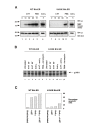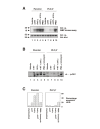A conditional form of Bruton's tyrosine kinase is sufficient to activate multiple downstream signaling pathways via PLC Gamma 2 in B cells
- PMID: 11410123
- PMCID: PMC32313
- DOI: 10.1186/1471-2172-2-4
A conditional form of Bruton's tyrosine kinase is sufficient to activate multiple downstream signaling pathways via PLC Gamma 2 in B cells
Abstract
Background: Bruton's tyrosine kinase (Btk) is essential for B cell development and function. Mutations of Btk elicit X-linked agammaglobulinemia in humans and X-linked immunodeficiency in the mouse. Btk has been proposed to participate in B cell antigen receptor-induced signaling events leading to activation of phospholipase C-gamma2 (PLCgamma2) and calcium mobilization. However it is unclear whether Btk activation is alone sufficient for these signaling events, and whether Btk can activate additional pathways that do not involve PLCgamma2. To address such issues we have generated Btk:ER, a conditionally active form of the kinase, and expressed it in the PLCgamma2-deficient DT40 B cell line.
Results: Activation of Btk:ER was sufficient to induce multiple B cell signaling pathways in PLCgamma2-sufficient DT40 cells. These included tyrosine phosphorylation of PLCgamma2, mobilization of intracellular calcium, activation of extracellular signal-regulated kinase (ERK) and c-Jun NH2-terminal kinase (JNK) mitogen-activated protein kinase (MAPK) pathways, and apoptosis. In DT40 B cells deficient for PLCgamma2, Btk:ER activation failed to induce the signaling events described above with the consequence that the cells failed to undergo apoptosis.
Conclusions: These data suggest that Btk:ER regulates downstream signaling pathways primarily via PLCgamma2 in B cells. While it is not known whether activated Btk:ER precisely mimics activated Btk, this conditional system will likely facilitate the dissection of the role of Btk and its family members in a variety of biological processes in many different cell types.
Figures





References
Publication types
MeSH terms
Substances
LinkOut - more resources
Full Text Sources
Medical
Research Materials
Miscellaneous

